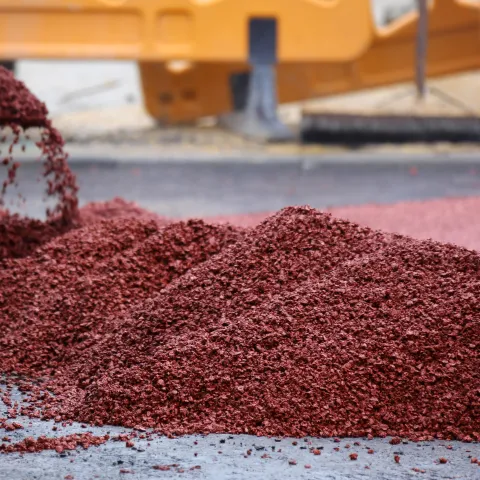How does the installation process for coloured asphalt differ from traditional black asphalt surfacing?

Coloured asphalt surfacing is the use of colour pigments, aggregates and clear binder that provide a specific colour, opposed to the traditional black or dark grey appearance of standard asphalt.
There are many reasons why using coloured asphalt is chosen, for example: aesthetic appeal; safety and visibility; demarcation; wayfinding and landmarks; branding and identity; and recreation and design purposes.
Here we explore the differences in the installation process between coloured and traditional black asphalt and why it’s essential to consider the specific requirements of the project, to ensure the desired results and longevity of the coloured surface.
Overview of Traditional Black Asphalt Surfacing
Brief explanation of traditional black asphalt
Traditional black asphalt is the most commonly used type of surface for roads, pavements, car parks and drives. It’s made from a mix of binder (or bitumen) and aggregates which typically include crushed stone, gravel or sand. The asphalt binder acts as a binding agent, holding together the aggregates to form a hard, solid and durable material.
Exploring the aesthetic and functional advantages of coloured asphalt
Coloured asphalt offers a visually appealing alternative to traditional black asphalt. It has a range of benefits, including the exploration of creative designs, colour combinations and patterns, which can really make the overall aesthetics of roads, paths, drives and other paved surfaces stand out.
Using coloured designs and patterns to highlight critical areas such as pedestrian crossings, bike lanes or disabled parking bays is an ideal way to incorporate coloured asphalt and can help improve visibility, especially during low light or adverse weather conditions.
Children's play areas can be significantly improved by the use of colour and design, helping to stimulate creative play and create an inviting, fun and friendly environment for children to socialise.
Cycle lanes benefit immensely from an injection of colour, for clear visual distinction between the lanes and road surface, enhancing safety for both cyclists and motorists and reducing the risk of potential collisions.

Calculate the tonnage of asphalt you need for your project. We can offer technical support and guidance to ensure you receive the highest quality performance for your project.
Key Differences in the Installation Process for Coloured Asphalt
Selection and preparation of colouring agents
The colouring agents, also known as pigments, are responsible for providing the desired colour to the asphalt surface and the selection and preparation of these is key during the installation process. Incorporating diverse coloured aggregates can also be used to attain specific hues.
Pigments are finely ground powders or granules that are available in a variety of colours and are the most used colouring agents, compared dyes and natural colourants. In some cases, coloured additives or modifiers can be used to achieve specific colours or to improve colour retention; these may include oxide, synthetic oxides or other proprietary materials.
An important consideration is pigment particle size, which can affect the colour dispersion and overall mix quality. Finely ground pigments usually provide better colour distribution and a smoother surface texture.
The chosen colouring agent must be compatible with the asphalt binder used in the mix. Incompatibility can lead to major issues such as poor adhesion, reduced durability or premature surface failure which can cause early surface deterioration, resulting in an inferior end product. That’s why the significance of closely partnering with technical professionals and conducting trials should be given prominent focus.
Mixing and blending coloured asphalt
The integration of the colouring agents into the asphalt mix involves careful blending of the pigments with the hot asphalt binder and aggregates to achieve the required colour. It’s only added once the aggregates have reached the desired temperature and is then carefully measured into the mixing drum.
Together, the asphalt mix and colouring agents are thoroughly combined to achieve a uniform distribution of colour throughout the mixture. The process ensures that the pigments are evenly coated and dispersed amongst the aggregates and asphalt binder. Allowing a consistent colour result throughout the whole job. This is particularly important on larger projects with multiple loads to ensure the colour is same throughout and joints are minimised.
Maintaining the correct temperature all the way through is essential to guaranteeing proper workability of the asphalt mix and effective blending of the colouring agent.
Due to the intricacies of the mixing and blending process, hands-on expertise is needed to achieve consistent colour, maintain performance standard, troubleshoot issues, ensure safety and ultimately deliver a high-quality end product.
Application techniques for coloured asphalt

A clean and properly prepared surface will mean the coloured asphalt adheres well to the underlying layers such as the binder course or base layer, which is crucial for the pavement’s robustness and long-lasting performance.
Adequate preparation will also contribute to the long-term durability of the coloured asphalt as it helps resist wear, weathering and the stresses caused by traffic, extending the lifespan of the road. Additionally, an even and smoother surface provides a better base for laying. Irregularities or rough patches in the underlying pavement can translate into an uneven final surface that affects ride quality for motorists and cyclists.
Another reason to prepare properly is to assist with uniform colour consistency, as any debris, stains or contaminants on the surface can negatively affect the final appearance of the coloured asphalt.
When it comes to structural integrity, putting time into preparation ensures that the coloured asphalt layer is supported by a stable foundation, which helps distribute loads evenly and prevents structural failures in the future.
Investing time and effort in surface preparation can lessen the likelihood of costly repairs and maintenance in the future by reducing the need for frequent interventions.
Overall, successful surface preparation is essential for a thriving-coloured asphalt project. It guarantees strong adhesion, lasting durability, precise colour rendering, structural soundness and safety, culminating in an attractive, enduring, and operational coloured asphalt surface.
There are several methods for applying coloured asphalt, each suited to different project requirements and surface conditions. It’s laid and compacted using conventional asphalt paving equipment such as pavers and rollers. This method is most suitable for large-scale projects like roads and car parks. All equipment must be thoroughly cleaned to an extremely high standard before use, to avoid any contamination with black asphalt that the equipment might usually handle.
The hand lay method is recommended with coloured asphalt, and can be used on smaller works or areas with limited access for large equipment. This involves manually placing, spreading and compacting the coloured asphalt mix with hand tools such as shovels, rakes and small rollers. This way of laying reduces the risk of contamination and is most commonly associated with paths, pedestrian areas and small decorative spaces.
Considerations for colour retention and durability

Coloured asphalt is exposed to various environmental factors, including sunlight (UV radiation), weather conditions and traffic loads, which can impact the colour's vibrancy and the overall performance of the pavement.
High-quality, UV-resistant pigments with excellent colour fastness properties should be chosen as these will maintain their colour intensity over time. Applying a protective surface coating with UV-blocking properties over the finished surface can form a barrier against UV radiation, helping to preserve the colour and longevity.
It’s important to implement a maintenance programme to keep the coloured surface clean and in excellent condition. Regular cleaning and sealcoating will help protect the surface from environmental stressors and help maximise the colour’s vibrancy. Ensuring the pavement has adequate drainage to prevent water pooling or ponding can also aid with colour retention.
Challenges and Solutions in Coloured Asphalt Installation

Maintaining colour consistency throughout the project
In order to produce an eye-catching and uniform appearance of the finished surface, maintaining colour consistency is key. Any variation in colour can negatively impact the overall look of the project.
It’s integral to the success of the finished surface to choose a supplier that uses high-quality colouring agents that are specifically designed for use in coloured asphalt. By conducting small-scale trials with different mixes and colouring agents, it’s possible to assess their consistency and allows for adjustment in pigment dosage or selection before full-scale installation. Material samples can also provide a great example of colour.
Customer collaboration and close coordination with technical and commercial teams are essential components to achieving consistent quality throughout the installation of coloured asphalt. This collaborative approach ensures that the customer's expectations are met while upholding technical standards and commercial viability.
Quality control measures during installation

During installation, implementing rigorous quality control measures becomes paramount. These measures centre on scrutinising workmanship and equipment utilisation, to guarantee the best results. Crucially, this involves refraining from subjecting the newly laid surface to traffic until it has fully set.
By closely monitoring workmanship, potential issues can be identified and addressed promptly, minimising the likelihood of defects or unevenness in the finished product. Effective use of equipment ensures that the application is uniform and adheres to established standards.
The decision to withhold traffic until complete setting is a safeguard against premature wear or deformation. Allowing sufficient time for the asphalt to solidify ensures its long-term durability and performance.
Incorporating these quality control practices instils confidence in the final outcome, ensuring that the coloured asphalt installation not only meets visual expectations but also aligns with the highest standards of functionality and longevity.
Case Studies
Conclusion
In conclusion, the successful application of coloured asphalt relies on a combination of thoughtful material selection, meticulous preparation, diligent quality control and ongoing maintenance. By considering all these factors, asphalt contractors can deliver aesthetically pleasing, durable and high-quality coloured asphalt pavements that enhance the overall landscape and meet the diverse needs of modern infrastructure projects.
Frequently Asked Questions
The installation of coloured asphalt differs from traditional asphalt primarily in the use of colour pigments and a clear binder. This requires careful selection and preparation of pigments, ensuring compatibility with the asphalt binder, and a meticulous blending process for uniform colour distribution. Expertise in handling these additional steps is essential for achieving the desired aesthetic and durability.
Coloured asphalt offers both aesthetic and safety benefits in urban areas. It enhances visibility in safety-critical areas like pedestrian crossings and bike lanes, and allows for creative design in public spaces. The use of vibrant colours and patterns contributes to urban aesthetics, making spaces more inviting and functional.
Maintaining the colour and durability of coloured asphalt involves using UV-resistant pigments and regular maintenance like cleaning and sealcoating. These practices protect the surface from environmental wear and help retain colour vibrancy. Proper drainage is also important to prevent water damage and prolong the surface's lifespan.
Ensuring colour consistency is a major challenge in coloured asphalt installation. This is addressed by using high-quality colouring agents, conducting trials for consistency, and close collaboration with technical teams. Quality control during installation, focusing on workmanship and equipment, is crucial for a uniform and long-lasting surface.
Coloured asphalt can generally be applied using the same equipment as traditional asphalt for large areas. For smaller or more intricate spaces, a hand lay method is recommended to reduce contamination risks. This involves manual placement and compaction, making it suitable for pedestrian areas and decorative projects.












